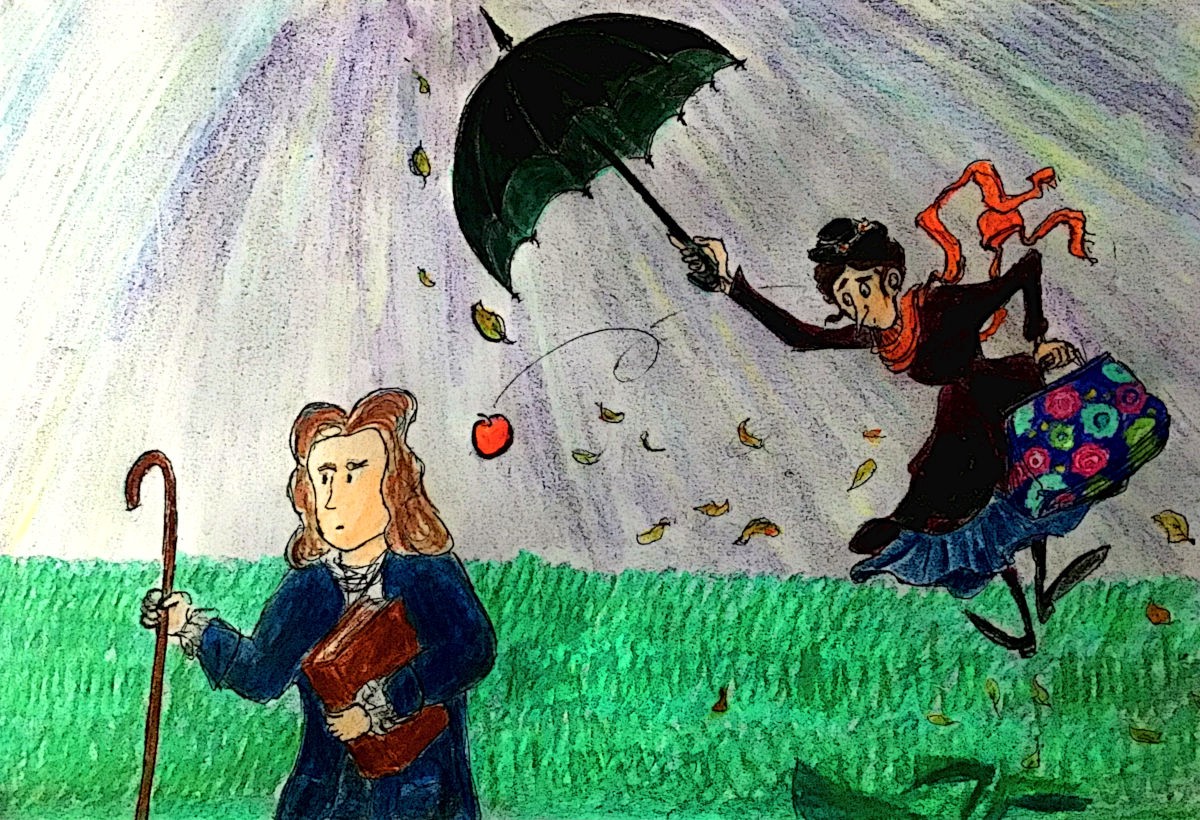The Last Sorcerer
Newton was an alchemist. Mary Poppins may have been a witch. What are scientists today?

Newton was an alchemist. Mary Poppins may have been a witch. What are scientists today?
Ever wondered where Mary Poppins came from? Or where she went? Or why none of her other employers freaked out and reported her to the police? Well, here’s one possible answer that would address all of those questions: Hogwarts.
Hang on for a second. Stay with me. It sounds preposterous at first, but it isn’t.
For starters, there’s that giant handbag of hers that holds everything — clothes, umbrellas, and even a lamp. No ordinary bag of yours or mine would ever hold all of that, not without being both very big and very heavy. But anyone who’s read Harry Potter would know that there’s actually a proper spell for that kind of thing — an undetectable extension charm. We see it used in all sorts of different contexts, and most prominently by Hermione in the final book on her beaded getaway bag. So why couldn’t Mary have done this too?
Magic would also help explain why she didn’t want the children to tell others about the funny goings-on. After all, the Statute of Secrecy prevents witches and wizards from revealing their existence to muggles. And if the Banks children were just witches and wizards in training, then Mary would have a reason and purpose to be there too, not to mention a reason to leave.
Think about it for a moment. Now that it’s been explained, it seems to just make sense doesn’t it?
Sir Isaac Newton, former master of England’s Royal Mint, is widely credited for sparking off the age of science. His idea that gravity followed simple mathematical rules became the template for all the science that came after.
Interestingly, it was Newton’s strong religious and spiritual bent that led him to his great discovery.
In Newton’s time, there were people known as ‘natural philosophers’ who paid close attention to nature to figure out how it actually worked — in other words, they were the precursors to modern-day scientists. Natural philosophers had turned their backs on the concept of “action at a distance”; your fate wasn’t decided by some conjunction of planets, they said, or by voodoo-esque mind control. They frowned down upon these ideas, and, incidentally, on weird pulls-you-from-afar phenomena like gravity.
But Sir Newton wasn’t a natural philosopher: he was more of an alchemist. Some think he was even searching for what alchemists are best known for these days: the Philosopher’s Stone, rumoured to make one immortal and turn baser metals to gold. Because of his alchemist’s background, Newton was familiar with ‘active principles’. According to alchemy, transformations or movements could be induced without physical contact, by manipulating the ‘active principles’ within an object.
That was how Newton formulated the idea of gravity working through nothing, at a distance, across empty space.
“Perhaps magic was once a mighty force in the world, but no longer. What little remains is no more than the wisp of smoke that lingers in the air after a great fire has burned out, and even that is fading. Valyria was the last ember, and Valyria is gone.” So says Maester Luwin, a member of the order of scholarly advisors in the world of A Song of Ice and Fire, George RR Martin’s epic medieval fantasy series.
The decline of magic is a recurring theme in fantasy: things used to be more magical, and magic more powerful, ‘in the olden days’. What’s behind it?
To answer that, perhaps we should first ask ourselves: what is magic, exactly?
Eminent science fiction writer Arthur C. Clarke once said that “Any sufficiently advanced technology is indistinguishable from magic”. Flip that around, and you find that magic is just a technology so advanced that you can’t begin to understand it. In olden days, there was more such technology around.
Wait a minute. More advanced technology? In olden times? Well — who said technology has to be by humans? The world’s best geoengineers are trees. The most powerful landscaper is an earthquake. In a world where human technology is newly beginning, what more powerful technologist is there than Nature herself? As we began to understand more of it though, the spell was lost. Over time, the world began to seem less magical.
One could think of magic as an early form of statistics. You find patterns and connections between things, although you don’t know how they work and why. What is today known as a ‘correlation’ may be nothing but a minor form of magic, except that it doesn’t have stories and explanations bundled along with it.
Let’s go back to the Mary Poppins theory for a second. The point of explaining it to you was not just to share the theory (although it is a pretty great theory if we say so ourselves), but this:
It was to ask, “Why does this theory exist?” Why did someone feel the impulse to take a narrative from one story, and try to shoehorn it into a magical logic system from a different story written half a century later?
The answer is simple: Boxes.
Humans have always felt an impulse to explain things we don’t understand. That’s where creation myths come from — the old folk tales of Ra from Egypt or Cronos and Rhea from Ancient Greece. It’s where this theory comes from, too. There’s so much about dear old Mary that is just never explained, but in Harry Potter we find a convenient framework through which to see her.
Science is also a box, born out of this very same impulse to systematize the world. Looking back at the history of science, all the grand theories we see as laughable like Phlogiston came from there too.
In older times, explainers often wore multiple hats and made a career out of explaining things — people like da Vinci, or Newton. When he was alive, Pythagoras of triangle fame doubled up as a mystic and miracle worker. Go back even earlier and you find the different roles of priest, physician, magician and scholar all melded into one person: the sorcerer.
Sir Isaac Newton lived at a time when this world was rapidly changing, but he was very much a part of it. As economist John Maynard Keynes once quipped, perhaps we should think of him not as the first scientist but as the last sorcerer.
Isaac Asimov, whom most people think of as Mr. Science Fiction, once wrote an essay about what good science fiction actually is. Incidentally, what he described is also good science.
There are some people, Asimov said, who write stories about spaceships and robots, but the stories could have worked out just as well without them. These are ordinary stories with ‘window-dressing’ of futuristic technology on top.
The other kind of science fiction — and the only good one, according to Asimov — is where some element of science is a key aspect of the story. Things can happen because the moon has lower gravity or because a certain element has certain fictional properties. The stories are mentally engaging because they have well-defined rules that you can try to work out on your own. There’s no “Deeper Magic” chapter that pops out of nowhere to overturn the “Deep Magic” you’ve been mentally following along with till now.
Such rules and limitations are what scientists work with every day. More interestingly, they sometimes apply to magic as well.
In his laws of magic, Brandon Sanderson talks about how a writer can effectively write a magic system. Here, the important one is his second law, which he sums up, very simply, by saying: “Limitations are greater than powers”.
So, what does this mean? Sanderson suggests that what makes fantasy so interesting is what our heroes cannot do.
Think about it for a second. To use the example Sanderson himself uses, Kryptonite makes Superman a much more interesting character than his ability to fly. As readers, we can easily see this. A fight in fantasy is always more interesting when the stakes are highest. And what makes the stakes higher than the possibility of not making it out alive?
Sanderson’s second law also helps by ensuring that characters can’t just snap their fingers and solve all their problems— that would make for a pretty boring story! After all, as he says, “Without limitations, there is no innovation.”
This way of looking at magic is fascinating, but relevant here because it blurs the lines between science and magic. Though his stories involve magic and fantasy, that magic has well-defined rules and limits, and can be analysed and investigated in a logical way. It’s like Asimov’s science fiction with a ‘‘window dressing’ of fantasy, so to speak.
If there’s one breakthrough that science has come up with, it’s the idea that the world is, to some degree, explainable. It’s not just random stuff happening all the time. Our world, science tells us, is more like Asimov’s and Sanderson’s than, say, the more fantastical world of Narnia.
Science is possibly the first belief system that doesn’t take what its elders say as absolute truth: experiments are re-run; new discoveries analysed; ancient theories overturned when a better one comes up to displace it.
That’s not to say people never changed beliefs in olden days. The history of humanity is peppered with discovery — as is the history of other apes, albeit to a lesser degree. That’s true even for delicate things like medicine. Before the scientific method, medical systems included some spurious cures and left out some real ones, but they’re what kept us going for thousands of years. People would go by trial and error, figure out what seemed to work, and move away from what didn’t.
Science, of course, does it quite a bit more systematically.
Integral to the scientific method today is Occam’s razor: the idea that, if you have a simple explanation for something, you shouldn’t use a complex one instead. Occam’s razor cuts a lot of the cruft, because it chooses the theory that can be explained in the simplest way, not the one that tells the best story.
If you or I were to look into a lab (assuming that you aren’t, in fact, a fancy scientist of some sort) then the things we saw wouldn’t make much sense.
Gleaming steel countertops, rows upon rows of sparkling test tubes, a machine or two that looked vaguely familiar but whose purpose we didn’t come close to understanding. We wouldn’t know if they were cooking meth or curing cancer. Or perhaps meth could cure cancer. Who knows? Not me.
There’s a certain blind faith we put into science, and by extension scientists. We trust that we’re in the same box, following the same metrics. There’s not much more we can do, unless we’re willing to put in the effort to become a scientist, work our way through academia, and actually use all that equipment to verify results for ourselves.
Instead, we trust that someone verifies the experiments for us. We take solace in the fact that, while we don’t necessarily understand what’s going in or what’s being done to it, we understand the system.
Science may be different from magic, but does it always look different? That’s a question that’s becoming increasingly hard to answer.
